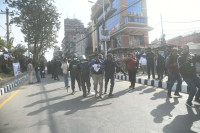Opinion
Lost spirit of 2036
Intersectionality of class and ethnicity is the need of the day for the Nepali left
Shreya Paudel
It was Chandragadhi, the district capital of Jhapa, where my father, Ramesh Kumar Paudel, grew up with his two brothers and his mother in difficult economic conditions in the 1970s. When he was about 14, he was influenced by his government school teacher, Kedar Neupane, the current central committee member of the CPN-UML, to stand up against the one party Panchayat system. Neupane began my father’s irreversible journey of becoming a socialist. To many cadres of my father’s generation, socialist ideals were about speaking up for Dalits’ rights, inciting societal reformation against gender discrimination, burning landlords’ property papers taken forcibly or in a deceitful way from poor farmers, protesting against police brutality and launching direction actions against the authority. It was about going through intense sacrifices for these ideals. Many spent years in prisons, many others gave up their lives and others were encouraged to give up their ‘bourgeoisie’ education. Underlining these ideals and sacrifices was a strong belief against the oppression of a human by another. I have even heard from my father that the likes of CP Mainali, one of the current six deputy prime ministers, had burnt his landlord father’s papers that had been grabbed from the poor farmers of Jhapa. Such were the days of Marxist-Leninist, the predecessor of UML (Unified Marxist-Leninist). Such were the revolutionary ideals dedicated to social and economic justice.
The transformation
Now, fast forward the world to 2015. UML and the major leftist parties of Nepal lead the government. The Madhes movement has been going on for several months. The police have taken the lives of more than 50 protestors. More importantly, the leftists are not demanding change; they are defending the system.
The rapid transformation of a leftist party like UML’s position on federalism from the first Constituent Assembly (CA) to the second CA has been stunning. It was the same UML which had proudly proposed its demarcation design of 15 states, which recognised ethnic groups, to the first CA. Now, it is doing its best to establish as few states as possible. People like me, who have heard about the party almost from their mother’s womb, deserve an answer: What changed the party’s ideas from the first CA to the second CA? Is Rajendra Shrestha, the former comrade of KP Oli and currently co-chair of the Sanghiya Samajbadi Forum Nepal, telling the truth when he claimed that the UML leadership sabotaged its own proposal of fifteen states put forward in the first CA?
Ethnic question
What the Nepali left largely and particularly of the Marxist-Leninist tradition needs to understand is that federalism is not just a technical question. It has been a political cry for many ethnic groups like the Janajatis and Madhesis. It is crystal clear like the bluest sky in the sunniest day that there has been a dominant ethnic group in Nepal. Be it the military, political parties, police or bureaucracy, I do not have to repeat which ethnic group dominates the leadership positions. The left was supposed to represent the issues of the Janajatis and Madhesis and to be with the underdogs and the discriminated.
However, it has come as an unfortunate truth that the Nepali left has largely overlooked the ethnic issue of inclusion during and after the second CA. Many will surely refute this by saying that the present constitution is the best in the world. Perhaps it is. But many others do not think so; they have been protesting against it for months. The amendments supported by the left also demonstrate that the constitution is not as perfect as it was made to appear. To be sure, some of the demands from ethnic forces like the Madhesis are not coherent with the overall interest of Nepal, for instance, the inclusion of districts like Jhapa in the Madhes Pradesh without consulting Jhapalis. However, in totality, it is the national left’s absence from ethnic politics that allows such radical ethnic claims to exist and continue.
Realpolitik
Forgetting the politics of principles and ideals for a bit and observing from a politically calculative perspective, leaving the case of caste and ethnicity is a disaster in the making for the Nepali left. This can be partly seen from the experience of the Indian left as well. As I was reading obituaries and past interviews of the veteran CPI leader AB Bardhan last week, I came across many points stating that the Indian left had not given due respect to the issues of caste and ethnicity either. When social movements based on ethnicity rose in 1980s and 1990s in states like Bihar, the Indian left did not lead it deliberately, paving the way for regional caste-based vote-bank politics. The result is to be seen in Bihar—the potential working and peasant class consciousness is impeded and replaced by regional and caste consciousness. But I do not see this as a fault of the regional parties. The fault lies in the Indian left, which largely failed to understand that there are other social cleavages like caste and ethnicity in our part of the world, and not just class as seen by Marx in the nineteenth-century industrial Europe.
Finally, my constructive criticism of the Nepali left is not from a rightist or regionalist perspective but from a leftist perspective itself. Let us get the spirit of 2036, 2046 and 2063 back. That obviously does not mean reverting to the totalitarian ideologies of the past. On the contrary, let us reclaim the revolutionary spirit of the past, accommodate it in the current socio-economic realities and take in the issues of the marginalised ethnicities as well. The inspiration of such eclectic democratic socialist choices can be taken from the popular successes of the Latin American social movements where many democratic socialist parties and Native American (ethnic) movements stand together. Otherwise, the names such as Marx and Lenin do not really matter much if a significant portion of the population does not feel that the left leadership can represent them. Each age needs its own leadership with its own ideas. In this age, the intersectionality of class and ethnicity is the need of the day for the Nepali left. As the son of a revolutionary father who had fled his home at the age of 15 for his inspirational party and who was tortured by the Panchayati police, I appeal to the Nepali left to represent the ethnic issues as well, both as a matter of social justice and realpolitik. Abhibaadan.
Paudel is pursuing an MSc in Conflict Studies at the London School of Economics and Political Science




 15.12°C Kathmandu
15.12°C Kathmandu










